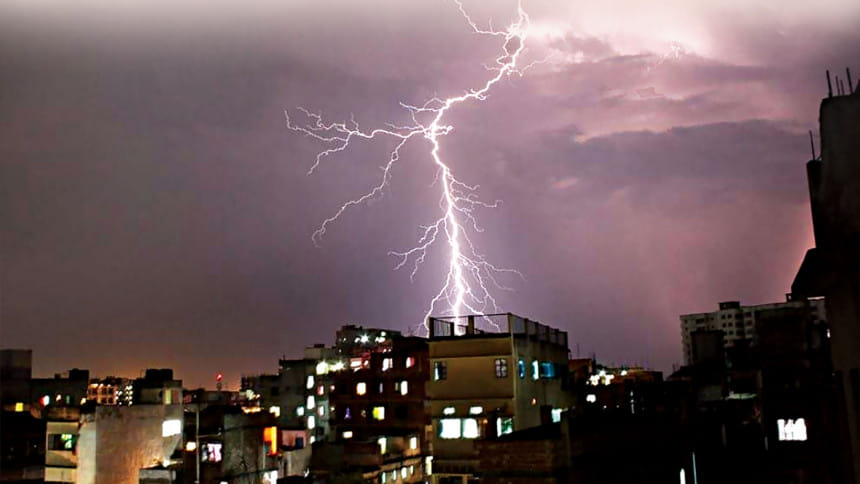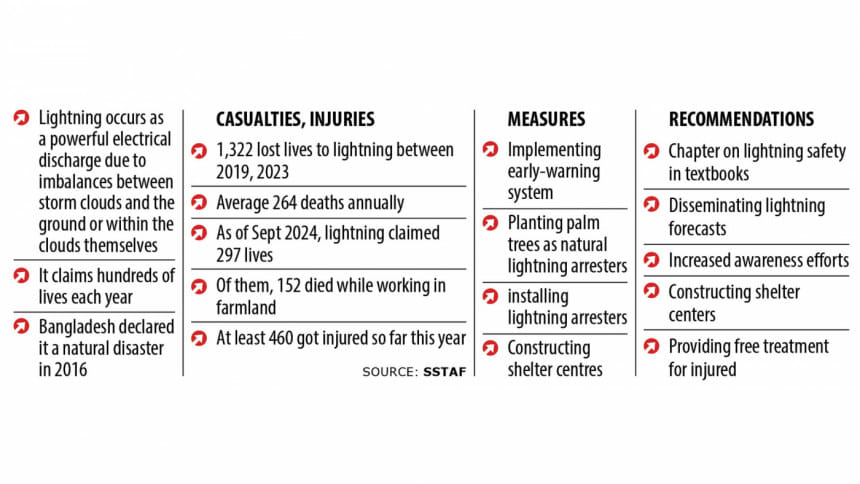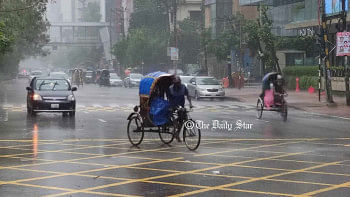How Bangladesh can reduce lightning deaths

As the sky darkens and the familiar rumble of thunder echoes across the horizon, farmers and fishermen working in open fields and water bodies sense the imminent danger of lightning. In Bangladesh, lightning is one of the deadliest natural disasters, claiming hundreds of lives each year.
Recognising its severity, the country declared lightning a natural disaster in 2016 and implemented measures to reduce fatalities.
However, experts believe there is still more that can be done.
Bangladesh could benefit from the successful strategies used by other Asian nations, which have significantly lowered lightning-related deaths through policy changes, advanced technology, and public awareness campaigns.
Learning from Asia's Best Practices
Singapore, a small island nation with one of the highest lightning frequencies in the world, has emerged as a global leader in lightning safety by leveraging advanced technology and strict regulations.
The country's National Environment Agency (NEA) has developed a real-time warning system that issues alerts through mobile apps and public signage.
This system has brought lightning-related fatalities close to zero, according to NEA reports, showcasing the effectiveness of proactive safety measures.
India launched the Damini app, providing real-time lightning alerts to millions of rural residents, helping them stay safe during storms.
This app, along with a widespread public awareness campaign, has led to a 22 percent reduction in lightning-related deaths, even as lightning incidents rose by 57 percent, according to a study from the Lightning Resilient India Campaign.
Likewise, countries like Nepal, Malaysia, Sri Lanka, and Thailand have achieved notable progress by implementing lightning forecasting technologies, raising public awareness, and developing supportive national policies.

Bangladesh's Efforts in Mitigating Risk
After lightning was declared a natural disaster in Bangladesh in 2016, authorities began formulating strategies to reduce the associated risks.
The Department of Disaster Management (DDM) initiated a long-term plan in 2017, planting millions of palm trees in rural areas, as these trees have historically acted as natural lightning arresters.
However, widespread criticism arose over neglected trees dying due to insufficient care, leading the former state minister for disaster management to announce the project's cancellation in 2022.
Lightning is a disaster that we cannot manipulate or control due to the lack of technological advancement. However, we can reduce fatalities by implementing adequate preventive measures.
Nonetheless, DDM officials confirm that palm tree planting continues as part of their regular activities, acknowledging its potential long-term impact on mitigating lightning risks.
The DDM is also implementing a focused project across 15 lightning-prone districts, where it plans to install 6,793 lightning arresters and construct 3,398 lightning shelter centers, according to officials.
Meanwhile, the Local Government Engineering Department (LGED) is adding another 1,400 lightning arresters across 14 districts, including seven already covered by the DDM.
Arun Kumar Chowdhury, the project director, clarified, "To avoid overlapping with the DDM's efforts, we are not placing arresters in open areas. Instead, we're installing them in 450 newly built shelters, union parishad complexes, hospitals, and rural markets, which are common gathering spots in these communities."
One of the most critical steps in mitigating lightning risks has been initiated by the Bangladesh Meteorological Department (BMD), which, in collaboration with NASA, recently implemented an early-warning system called the High-Impact Weather Assessment Toolkit (HIWAT).
"With this advanced system, we can now predict potential lightning strikes within a 30-kilometer radius, providing alerts up to 30 minutes before lightning occurs," explained Dr Md Shameem Hassan Bhuyian, deputy director of the Storm Warning Centre at BMD.
Lightning and Grim Reality
Despite various efforts since 2016, lightning strikes in Bangladesh continue to claim lives, with fatalities on the rise as climate change drives more frequent lightning events.
Lightning, a natural phenomenon, occurs as a powerful electrical discharge due to imbalances between storm clouds and the ground or within the clouds themselves.
According to the recent research paper "GIS-Based Spatial Analysis for Lightning Scenario in Bangladesh", the majority of lightning fatalities occur during the pre-monsoon and monsoon seasons, with the northern and northeastern regions identified as the most vulnerable areas.
Save the Society and Thunderstorm Awareness Forum (SSTAF), an NGO monitoring lightning-related casualties since 2019, reports that 1,322 people lost their lives to lightning strikes between 2019 and 2023, averaging 264 deaths annually.
As of September this year, lightning strikes have claimed 297 lives, including 34 children and teenagers, and injured 460 individuals. Notably, 152 fatalities -- 48.82 percent of the total -- occurred while victims were working in farmland, underscoring the high risk faced by rural workers in open areas.
What's Next for Bangladesh?
The experiences of Singapore, India, and Malaysia offer valuable insights for Bangladesh, particularly in developing a national real-time lightning warning system to protect vulnerable populations.
Professor MA Farukh from the Department of Environmental Sciences at Bangladesh Agricultural University noted, "Lightning is a disaster that we cannot manipulate or control due to the lack of technological advancement. However, we can reduce fatalities by implementing adequate preventive measures."
He commended the initiative of planting palm trees as a long-term strategy and suggested the addition of betel nut trees to enhance natural protection.
Furthermore, he emphasised the need for short- and mid-term policies, including the installation of alert systems, lightning shelters, and advanced technologies.
Disaster management expert Gauhar Naeem Wara highlighted that deforestation significantly contributes to rising fatalities and advocated for increased tree planting as a means to save lives.
"The installation of adequate lightning arresters in farmlands and water bodies, where the majority of fatalities occur, is essential. Additionally, a medical protocol for managing patients injured by lightning strikes needs to be established," emphasised the expert.
Dr Md Shameem Hassan Bhuyian of the Bangladesh Meteorological Department said, "With our advanced technology now capable of alerting people at least 30 minutes before a potential lightning strike, we need an effective method to disseminate these alerts."
"We recently held a meeting with the Department of Disaster Management and telecom operators to discuss implementing a system for alerting at-risk individuals. By utilising mobile towers to send voice call alerts to users within the dangerous radius, we could potentially save hundreds of lives," he added.
Dr Bhuyian noted that in collaboration with Japan International Cooperation Agency (Jica), the Bangladesh Meteorological Department has developed awareness materials aimed at educating communities about lightning safety.
These materials are ready to be distributed to help raise awareness and promote protective measures among the public, he said.
Rashim Mollah, general secretary of Save the Society and Thunderstorm Awareness Forum (SSTAF), with extensive experience addressing the issue of lightning fatalities, the organisation has recently called on the government to implement a five-point strategy to reduce deaths.
They advocated for several key initiatives, including the inclusion of a mandatory chapter on lightning safety in school textbooks. Additionally, they emphasised the importance of disseminating lightning forecasts -- now available up to 30 minutes in advance -- through government channels.
They also called for increased awareness efforts aimed at farmers and the general public through meetings and seminars.
Furthermore, they highlighted the necessity of constructing shelter centers in open farmlands and providing free healthcare services for those injured by lightning strikes.

 For all latest news, follow The Daily Star's Google News channel.
For all latest news, follow The Daily Star's Google News channel. 



Comments